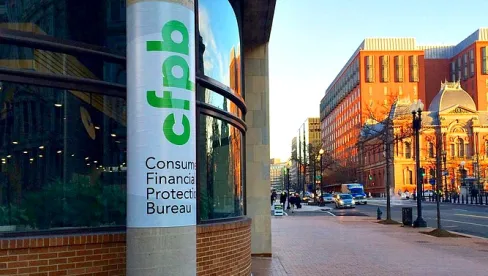On 5 April 2021, the Consumer Financial Protection Bureau (CFPB) solicited comments on proposed amendments to Regulation X,1 which amendments are intended to assist mortgage borrowers impacted by the COVID-19 pandemic.2 Though the proposal to extend the current foreclosure moratorium to January 2022 is gaining the headlines, it is important to note that the proposed amendments, if adopted, once again require modification to servicers’ existing loss mitigation programs in order to “maximize the likelihood that borrowers exiting forbearances have sufficient time to complete a loss mitigation application.” 3
The CFPB’s proposed amendments represent the latest attempt to provide relief to residential mortgage borrowers. In March 2020, the Coronavirus Aid, Relief, and Economic Stimulus Act (CARES Act) sought to provide immediate relief to mortgage borrowers impacted by the COVID-19 pandemic. Pursuant to the CARES Act, servicers of federally-backed residential mortgage loans were required to provide homeowners impacted by COVID-19 with payment forbearance for up to 180 days and, if necessary, extend the forbearance period for another 180 days. As anticipated, numerous borrowers entered into forbearance plans and obtained extensions of the plans. Further, in June 2020, the CFPB amended Regulation X in response to the wave of forbearances to address certain streamline modification procedures introduced by Fannie Mae and Freddie Mac. Now, the CFPB is once again proposing to amend Regulation X. Although many servicers are already working with their borrowers on post-forbearance options, the CFPB’s latest proposed amendments are aimed at preventing an anticipated wave of “avoidable” foreclosures and ensuring that servicers provide any borrower facing post-forbearance foreclosure with a range of options to remain in the home.4 If the amendments are adopted, we expect that the CFPB will use its supervisory and enforcement powers to further those objectives.
First and foremost, the CFPB’s proposal warns mortgage servicers that the industry must be prepared to adequately assist borrowers with forbearance periods that will end in the near term by taking steps to keep those borrowers in their homes. Specifically, the proposed amendment seeks to (1) codify the definition of a “COVID-19-related hardship,” (2) modify early intervention requirements to provide COVID-19-impacted borrowers with additional information regarding loss mitigation options, (3) allow servicers to use incomplete information to make determinations on certain streamlined loan modification products, and (4) implement a foreclosure review period that would generally prohibit servicers from issuing the first notice or filing on foreclosure proceedings before 1 January 2022.5 Responding to the urgency of the situation, the CFPB seeks comments regarding the impact of the proposed changes on an expedited basis.6 The comment period runs until 10 May 2021, with an effective date of 31 August 2021.7
Below, we discuss the proposed amendments and their rationale and highlight the circumstances where the CFPB expects mortgage servicers to take all necessary steps to ensure that borrowers are fully aware of loss mitigation opportunities to avoid foreclosure.
CODIFYING THE DEFINITION OF “COVID-19-RELATED HARDSHIP”
The CFPB seeks to codify the term “COVID-19-related hardship,” which includes “a financial hardship due, directly or indirectly, to the COVID-19 emergency as defined in the Coronavirus Economic Stabilization Act, section 4022(a)(1) (15 U.S.C. 9056(a)(1)).”8 While an immediate focus of the CARES Act was on mortgage payment forbearance, once implemented as part of the proposed amendment to Regulation X, the broad definition of a “COVID-19-related hardship” will also have an expansive application to loss mitigation and foreclosure generally. The absence of a sunset provision indicates that claims for COVID-19-related hardships may last significantly longer than the COVID-19 emergency itself. Regardless, the term’s broad scope signals that the CFPB is focused not only on borrowers who are already in forbearance programs, but also on borrowers who are currently delinquent but not yet in an active loss mitigation or forbearance program.
CHANGES TO THE EARLY INTERVENTION OBLIGATION
In its current iteration, Regulation X requires servicers to attempt to make live contact with the borrower no later than the 36th day of delinquency and specifies the steps that servicers must take when discussing loss mitigation options.9 The CFPB proposes to modify the early intervention mandates to temporarily require servicers who make live contact to identify whether the borrower’s account is in a forbearance plan.10 If the borrower is not in a forbearance plan, the servicer must expressly ask whether the borrower is experiencing a COVID-19-related hardship and provide information about available programs to assist the borrower, and the steps the borrower must take to benefit from those programs.11 If the borrower is already in a forbearance plan, then during the last live contact before the end of the plan period, the servicer must provide the borrower with the date on which the forbearance plan ends, details regarding available loss mitigation options available to the borrower, and the steps needed for the borrower to obtain additional loss mitigation assistance.12
In seeking comments on this section, the CFPB acknowledges the uncertainty around the level of detail that servicers must provide to borrowers regarding loss mitigation options. The CFPB seeks input on whether servicers should provide a list of all possible loss mitigation options or only those applicable based on the type of forbearance program the borrower had previously entered.13 Nevertheless, the CFPB’s comments make clear that it is imperative that borrowers, particularly those already in forbearance programs, receive sufficient and timely information so that those borrowers do not shift from forbearance directly to foreclosure without sufficient notice of their options and the opportunity to avail themselves of those options.14 Given the uncertainty regarding the level of detail that must be provided, servicers will need to be flexible and consider how to adjust their processes to ensure that their customer service representatives provide the requisite level of detail during live contact sessions.
USE OF INCOMPLETE APPLICATION FOR LOSS MITIGATION ANALYSIS
Currently, servicers cannot make a loss mitigation offer to a borrower based on an incomplete application unless permitted by the exceptions set forth in Regulation X. In the summer of 2020, the CFPB enacted Section 1024.41(c)(v) to allow for limited review of incomplete applications as it relates to the deferral of forborne payments. The CFPB now proposes to add another exception that authorizes servicers to issue loan modifications based on incomplete applications where the borrower meets the following criteria:
(1) the loan modification extends the term of the loan no more than 480 months and does not cause an increase in the required principal and interest payment;
(2) any amounts that are deferred until refinance, sale, or maturity do not accrue interest; the servicer does not charge a fee for the modification; and the servicer waives all late charges, penalties, stop payment fees, or similar charges upon acceptance of the modification;
(3) the loan modification is made available to borrowers experiencing a COVID-19-related hardship; and
(4) either the borrower’s acceptance of the loan modification or acceptance of the loan modification through satisfaction of a trial plan must resolve any preexisting delinquency.17
If the borrower accepts a loan modification based on the above criteria, the servicer is not obligated to comply with the requirements to provide notice of receipt and review a loan modification application as set forth in other sections of Regulation X. The proposed regulations, however, would require a servicer to immediately resume loss mitigation efforts if the borrower fails to fulfill the trial plan requirements or if the borrower requests additional assistance.18
In explaining the newly-proposed amendments, the CFPB notes that the COVID-19 pandemic presented an extraordinary circumstance and that borrowers suffering from the pandemic’s social and financial impacts may not be able to complete full applications.19 The proposed amendments state that many of the streamlined modifications use simplified application procedures and do not require complete loss mitigation applications.20 In allowing certain modifications to proceed without requiring complete applications, the CFPB recognizes that servicers need flexibility to efficiently evaluate loan modification options and ensure that the servicers can devote their resources accordingly. The CFPB believes that if servicers can avoid having to track down additional information and grant an investor-approved modification based on streamlined information, servicers can then refocus efforts to continue loss mitigation outreach to impacted borrowers.21
These proposed amendments are not without risk. Servicers will need to continue to closely scrutinize how they can implement the loss mitigation provisions without running into some of the same litigation issues arising out of the Home Affordable Modification Program (HAMP) established in 2008. Although successful in providing loan modifications to numerous borrowers, servicers’ HAMP efforts led to a host of litigation, ranging from individual lawsuits to class actions in state and federal courts throughout the country, as well as challenges in bankruptcy courts through adversary proceedings and objections to servicers’ claims and payment change notices.22 Litigation focused on loss mitigation is likely to mimic HAMP related litigation, and could include disputes regarding the affordability of modifications offered at the end of the forbearance period, the terms of the modifications (including trial plan terms and payments), the servicer’s and investor’s decision to not offer certain loss mitigation options, and the impact of unpaid escrow amounts owed on payments following a modification. If the CFPB enacts the proposed amendments, servicers should take care that they continue to document all aspects of the loss mitigation process and provide a clear explanation to borrowers regarding the type and terms of any loan modification offered following forbearance to minimize the risks of a HAMP-like litigation wave in 2022 and beyond.
IMPLEMENTATION OF SPECIAL COVID-19 EMERGENCY PRE-FORECLOSURE REVIEW REQUIREMENTS
In response to the COVID-19 pandemic, foreclosure moratoriums were implemented by state executive orders, federal agency decisions, and investor mandates. As the COVID-19 emergency begins to wane, certain jurisdictions and investors are positioning to relax foreclosure moratoriums. In the absence of any foreclosure moratorium, a servicer is ordinarily prohibited from issuing the first notice or filing required by applicable law for any judicial or non-judicial foreclosure process, unless: (a) the account is more than 120 days past due, (b) the foreclosure is based on a violation of the due-at-sale clause, or (c) the servicer is joining a foreclosure brought by a superior or subordinate lienholder.23
With the proposed amendments, the CFPB seeks to add a new paragraph (3) to Section 1024.41(f), requiring a servicer to wait until after 31 December 2021 to issue the first notice or filing.24 As proposed, a servicer can only proceed with the first notice before 31 December 2021 if the first notice is as a result of (a) a violation of the due-at-sale clause, or (b) the servicer joining a foreclosure brought by another lienholder.25 The CFPB’s stated goal in limiting the first notice or filing is to ensure that every borrower has the ability to understand and take advantage of all suitable loss mitigation options prior to foreclosure.26 The CFPB is concerned that borrowers and servicers may need additional time to provide meaningful opportunities to evaluate foreclosure avoidance options.27 In fact, under the proposed regulations, a servicer’s failure to timely attend to loss mitigation could result in violations of Regulation X.28 Although the operational enhancements adopted in the wake of the 2008 financial crisis placed servicers in a better position to handle a high volume of defaulted accounts, and although many servicers have already adapted to the new rules and guidance following the enactment of the CARES Act, the CFPB nevertheless believes that servicers have faced, and will face, significant challenges in responding to fast-changing circumstances such that additional regulation is warranted.29
Additionally, the CFPB seeks to clarify whether servicers should be permitted to foreclose in situations where the borrower fails to respond to outreach efforts. Specifically, the CFPB is considering exemptions that would allow servicers to make the first foreclosure notice or filing before 31 December 2021 if (1) the servicer has completed a loss mitigation review and the borrower is not eligible for any program, or (2) the servicer has made certain efforts to contact the borrower and the borrower has not responded (“potential foreclosure exemptions”).30 To the extent that servicers support the potential foreclosure exemptions and wish to begin foreclosure efforts prior to 31 December 2021, servicers must ensure that sufficient documentation exists to support the potential foreclosure exemption and to limit risk associated with challenges as to whether an account meets the potential foreclosure exemption criteria.
CONCLUSION
If implemented, the CFPB’s proposed changes to Regulation X will mandate how servicers must evaluate loan modification applications and foreclosures in the near term, and how servicers must handle their early intervention live contact attempts. Servicers should consider whether the CFPB’s expectations clash with the reality of business operations and begin to prepare now for the influx of loss mitigation requests that will likely occur in the coming months. If nothing else, the proposed amendments signal that the CFPB expects that servicers must provide any borrower experiencing a COVID-19-related hardship with the opportunity to participate in loss mitigation efforts. Similarly, servicers can expect that compliance with the new rules will be a priority for the CFPB moving forward. Perhaps most importantly, servicers must recognize that failure to comply with the proposed amendments, if enacted, could result in adverse CFPB actions, individual and class action litigation by borrowers in state, federal, and bankruptcy courts, and other negative consequences.






 />i
/>i

